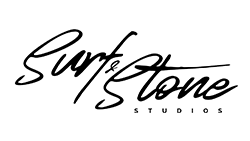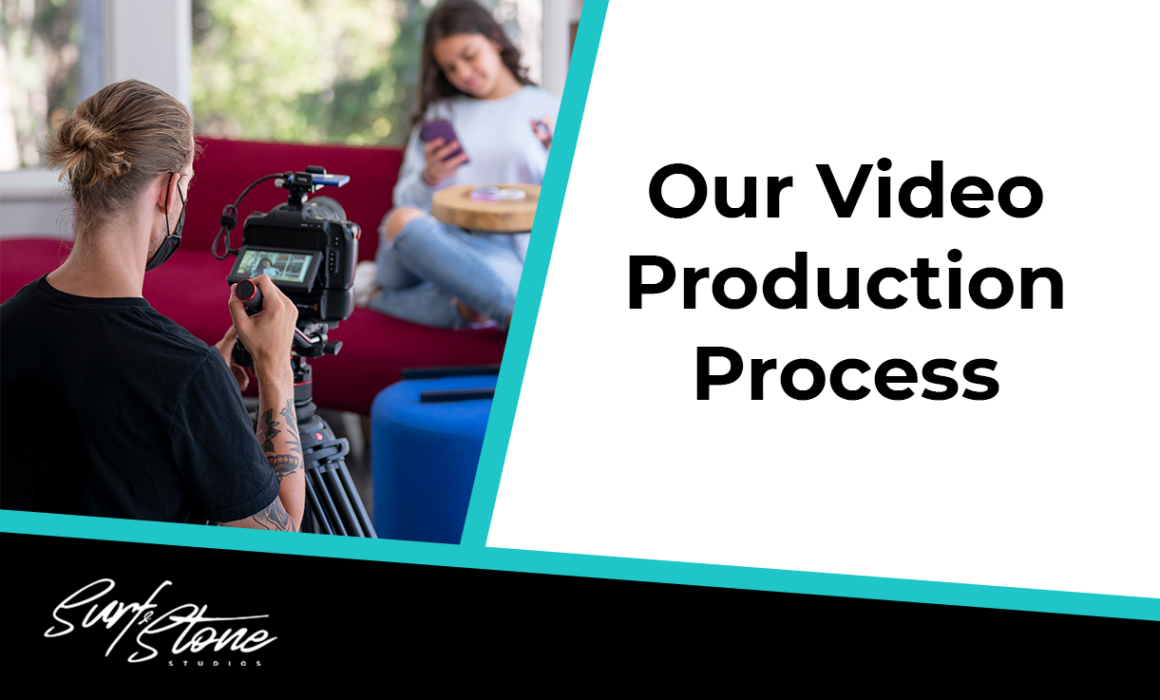Surf and Stone Studios: Our Video Production Process
We put a lot of consideration into our video production process to ensure that your brand is properly positioned. We need to be intentional with what we include in our videos and our process helps us achieve that.
Many times, people don’t realize all of the steps that are involved in the process so we want to be transparent about all of the work that goes into making a successful video.
Keep reading to the bottom to get an idea of how much our video production packages cost!
We acknowledge that we live, work and create on the traditional territory of the Songhees, Esquimalt, and W̱SÁNEĆ nations.
Learning About Your Brand

When we first meet, we’ll have lots of questions. Our goal is to learn as much as we can about you, your business, brand, and challenges. An effective branded video will align your business with your brand values in the eyes of your customers and allow you to position your business in such a way that can overcome your organizational challenges.
Most of these questions fall into the following categories:
Your Business: Who are you?
Telling us the basics of your business gives us a platform to move forward from. When we know what products or services you offer, where you offer them, and who your customers are, we develop an understanding of the industry and space that your business is operating in. When we’re developing a video or series of videos for you, this helps us to build a framework of what’s common in your industry and what can we do differently to help you stand out.
Your Brand: What makes you different?
Knowing why your customers choose you over your competitors is what allows you to connect with your customers on a deeper level (aka. your Unique Value Proposition). Any videos that we produce will need to enhance your branding, so we need to know what values are integral to your business.
Your Future: What challenges lie in your way?
Whether you’re trying to get more sales, promote a new product, or increase brand awareness, you’ll need a unique approach that’s customized to your brand. An effective branded video campaign will position your brand to overcome an organizational challenge in the eyes of your customer.
Pre-Production

Concepting an Idea
We ask ourselves several questions at this stage. We want to make sure that the idea we land on is going to effectively convey your message to your target audience. Sometimes this is a single video and sometimes it’s a series of videos or a combination of different types of media. In the concepting stage, we try to define what the core messaging is going to be and create a vision for how the video should look and what emotions we want to convey. We take these as a guideline for the rest of our production process.
Scriptwriting & Generating Questions
Since we have a specific goal for your video, we will often write a script to guide the production process. Even if we’re conducting interviews, it helps to have an idea of what talking points we need and the accompanying visuals that we want to capture. This is an opportunity for you to get a glimpse of where we’re going with the process and allows for you to give input and verify the direction that we’re headed. We want to make sure that you have a clear idea of what the video will look like so that we can minimize any possible misrepresentations.
Once we have this approved, we put the structure into a series of questions. We word these based on the points we’ve outlined in the script and structure the interview into a casual, conversational tone. It can be a delicate process to get the stories that we need with an authentic tone sometimes and we put a lot of thought into how we can achieve this.
Storyboarding
This is not always required, but for heavily scripted concepts we find it beneficial to construct a storyboard for our projects. As the script focuses more on what will happen in the video and what shots we need, the storyboard solidifies how each shot is going to look. If we’re going to use a lot of graphics or text in your video, we likely need to plan each shot so that there is enough space for the copy we’ve approved.
Location Scouting, Casting & Recruiting Crew
For most people, this is the biggest barrier to producing their own videos but we have an extensive network of creatives, creative spaces, and talent to draw from. We often visit locations in advance and evaluate them based on the space, lighting, location, accessibility in addition to how well it aligns with the vision for the video. We have strong relationships with local talent agencies to source models or actors and we can source a crew to fit the needs of each project. If we need an additional camera operator, stylist, hairdresser, photographer, etc. we can bring them on to help bring your video to life.
Shot listing
This is a crucial part of the process that happens behind the scenes. Our team goes through the script, storyboard, and plan for the day and writes down all of the necessary shots that we need. This ensures that when we’re in the middle of production we don’t miss a crucial shot and sacrifice any portion of your messaging. As a creative agency, we still love having the freedom on set to pursue other shots but our shot-list serves as our creative safety net and allows us.
Production

Call Sheet
During the week before our production date, we’ll send out a call sheet to everyone involved in the shoot. This has all the information that might be needed by anyone involved on the day. Who is needed, when to show up, where to go, what the weather will be like, where to park, what times are we shooting different scenes, and what the vision is for the day. This ensures a smooth schedule on the day of and reduces the need for last-minute coordinating.
Arrival and Set-Up
For directed scenes and interviews, we like to have an hour to set up. This allows us enough time to decide on the backdrop and lighting style. Once we have that, we’ll add or remove different items from the frame to make sure we add depth and character to the environment. It’s always good to have enough time to try out some different options because we want to go with the best-looking setup and sometimes it can be hard to know without trying different options.
Arriving early also allows us enough time to test our audio. If we’re recording an interview, we want to know that we’re getting a clean feed and might need to try some different microphones if there’s any noise in the background.
Depending on the size of the production, we also like to have some time to chat with the crew, talent, and your team members to create a friendly and fun atmosphere. We’ve found that a more enjoyable culture on set directly translates to better performances on camera and that’s exactly what we want for your video
Directing
The director is responsible for creating and achieving the vision set out in our pre-production process. Onset, this can vary quite a bit depending on the scope of the project. It could be working with actors to get the performance that we want or it could be asking questions during an interview to get the talking points that we need. Sometimes we run a tight crew to meet your budget and the director may even be operating the camera.
Interviews
Although we like to have control over where we’re shooting, sometimes it’s necessary to work within the space that we have available. When we set up an interview, we like to tweak the appearance of the background and make sure that everything comes across great on camera. We prefer a natural approach to lighting, we often will use the existing natural lighting in the space as a base and use our lighting kit to complete the look that we’re going for. If we’re running a multi-cam interview, we find that it helps to ‘light the scene’ rather than light a specific angle so that both cameras have a beautiful shot. Typically, we’ll use one camera to show the subject in their space and the other camera as a close-up to show more of the emotion on their face.
During the questions, we like to create a conversational tone. This helps get the soundbites that we need without having them feel forced. Sometimes we’ll ask for an answer to be reworded and other times we’ll wait and circle back to a topic when we feel there’s a natural point in the conversation. Being an interviewer requires a lot of awareness to direct the conversation while being cognizant of the responses that we get.
If you’re going to be on camera, we’ve put together these tips to help you prepare for your interview!
B-Roll
Here is where a lot of the creativity gets to come out. We capture all of the pieces we need to visually portray the story that we’ve outlined in the script and try to capture it in the most appealing way. We like to rely on the eye of our DoP or other camera operators during this stage. For any processes or actions, we break it down into steps and capture different angles for each. For new environments, we try to capture any features that represent the atmosphere and experience of the space. In a kitchen, this could be the delicious fresh plate of food or on a beach, it could be the wind blowing through blades of grass. We check all the safety shots from our shot list and then get as creative as we can.
Clean Up and Departure
We always like to leave locations in the way we found them and this means taking care of the space throughout the day and cleaning up after ourselves. Once we pack up all of our equipment, we do a walk-through to collect any garbage and make sure that any props or decorations have been put back in their places.
Post-Production

Editing Footage
This is the most time-intensive stage of our whole process. Our editors receive all of the footage and creative notes that we created in pre-production. From there, they categorize and sort all of our clips and get to work.
Audio and interview footage has to be lined up and reviewed. Sometimes we have several sound bites that will fit and they need to select the best. Often, we will have 8-10 minutes of usable footage and will have to trim it down to 1 minute for a 2-minute brand video that breathes. We have a structure that we’re going for, but how that structure takes forms is largely up to the interpretation and creativity of the editor.
We add in audio and some graphics before delivering the first draft of the video. At this stage, we’re looking for feedback on the structure of the video. We don’t pay too much attention to the sound design or colour of the video, because any structural changes will mean that it all has to be redone in the final cut.
Revisions
We like to use FrameIO to deliver our projects. It allows you to share the video with your team and everyone can make notes with timestamps on the video. Our standard video production packages will include two rounds of revisions. We don’t limit the number of revisions within a round but typically these are fairly small given the planning and communicating we do in pre-production.
If additional changes or revisions are needed after the second round, we’re happy to help but the pricing may need to be adjusted to reflect the additional work.
Approval & Picture Lock
After revisions, we go through a ‘picture lock.’ This means that the clips won’t change after this step. It’s important to have a picture lock because we can send the video off for sound design and colour correction/colour grading without worrying about any changes. Even a small change, like extending a clip may require a lot of changes to line up the music and make sure appropriate sound effects are timed properly. Any changes to clips or framing could also significantly change the colour grade for the clip.
Sound Design
Attention to sound design is the difference between an attractive video and an immersive experience. First, we adjust the interview audio to remove any noise and then we tweak the music to match any pauses or breaks. From there, we like to have a lot of fun pulling sound effects for all of the visuals and lay them into the background. If it’s a car driving by, steps on the concrete, or a river in the background, we subtly lay in the sound. This aspect of videos is often overlooked but has a significant impact on the quality of the final video.
Colour Correction & Colour Grading
Colour correction is the part of the process where we go through every clip in the video and make sure they match. We want white to be neutral in every shot, and we need to make sure that colours match every time they appear in the video.
Once we have the colour corrected, we can go through the colour grade. This is a more stylistic approach, and it’s what gives the footage a consistent ‘feel’ throughout the entire edit. We have professional tools that allow us to touch up all of the colours and create custom looks that bring out the best of the footage.
Visual Effects
We leave most visual effects until the end, this is where we can add any atmosphere (like mist, smoke, steam, light beams, etc.) or touch up any graphics. Often, this part is highly integrated with the colour correction process. If we’re adding any overlays, we’ll colour correct the footage first, then add the visual effects, and complete it with our colour grade. We also take this occasion to add the final touch-ups to titles, lower thirds, or opening/closing cards.
Final Delivery
Once the final edit is put together, we will then cut together with any remaining social media spots, highlight videos or website banners, and deliver on FrameIO. We like to follow up with our clients after the videos have been shared so that we can learn more about how the video was received and how effective the results have been. This helps us learn and improve our process when designing future video campaigns.
Budget: How Much Does Video Production Cost?

This is a question that we get often and it’s a fair one. When it comes to marketing expenses, it’s not just a question of how much it will cost but what the return will be. We understand that you need a positive return on investment for any investment and are happy to work with you to ensure that your video campaign is profitable.
The cost of our productions range from $5,000-$15,000 with the average video campaign sitting around the $7,000 mark. Most of our video campaigns will include 3-5 videos, which puts the average cost per video between $1,500 – $2,500.


